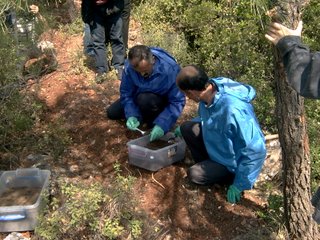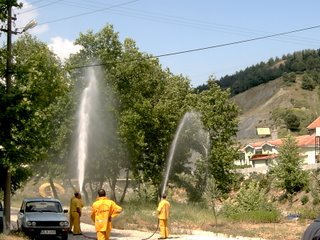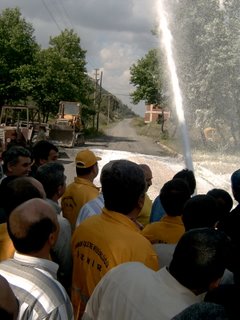Pazartesi, Mayıs 29, 2006
Salı, Mayıs 23, 2006
Ağustos' ta Mars

Mars gezegeni Ağustostan itibaren geceleri gökyüzünün en parlak cismi olacakmış. Mars çıplak gözle dolunay kadar büyük görünecekmiş.
27 Ağustos'ta Mars dünyaya 34,65 milyon mil yaklaştığında en büyük göründüğü gün olacakmış. 27 Ağustos gecesi 00:30'da gökyüzünü izlerseniz bu doğa olayına şahit olursunuz.... Dünyanın iki ay'ı varmış gibi görünecekmiş.
Mars'ın dünyaya bu kadar yakın geçeceği bir sonraki tarih 2287 yılında olacakmış. Bunu dostlarınızla paylaşın. Bugün hayatta olan hiçbir kimse bu olayı tekrar göremeyecek .
27 Ağustos'ta Mars dünyaya 34,65 milyon mil yaklaştığında en büyük göründüğü gün olacakmış. 27 Ağustos gecesi 00:30'da gökyüzünü izlerseniz bu doğa olayına şahit olursunuz.... Dünyanın iki ay'ı varmış gibi görünecekmiş.
Mars'ın dünyaya bu kadar yakın geçeceği bir sonraki tarih 2287 yılında olacakmış. Bunu dostlarınızla paylaşın. Bugün hayatta olan hiçbir kimse bu olayı tekrar göremeyecek .
Pazar, Mayıs 21, 2006
2006 EUROVISION SONG CONTEST
Bir Eurovision Şarkı Yarışması daha 20/05/2006 tarihinde saat 22:00'de yeni değişikliklerle yapıldı. Daimi yarışmacı ülke olmak ne güzel... Hiç telaş yok dereceye giremeyeceğim diye. Gerçi şarkı yarışmasından daha çok ülkelerin siyasi güç yarışması demek daha doğru olacak. Seneye bizi temsil edeceklere şimdiden yarı finalde başarılar... Bu arada Ermenistan'da Avrupa'daymış. Kimilerin işine gelince Azerbaycana kadar Avrupa, işine gelmeyince Meriç Irmağına kadar Avrupa diyorlar. Meğer ne kadar değişiklik gösteriyormuş bu kıta sınırları. Yıkayınca daralıyor, çekiştirince uzuyor...
Yunanistan'ı yaptığı iyi organizasyondan dolayı tebrik etmek lazım. Parçalar arasında gösterilen Yunanistan'ı tanıtıcı reklamlar gayet iyi olmuş. Aslında Karagöz & Hacivat, Baklava, Kemençe, Horon vb aslında Yunan kökenli kültüre aitmiş. Peki bu Türklerin kültürü nerede acaba? Biz neden asırlık olan bu kültürümüzün eserlerine sahip çıkamıyoruz yada onları iyi tanıtamıyoruz? Geçen sene birinci olan Helena'nın parçası "My number one" Anadolu motifleri ile hazırlanmış bir parça. Bizim gönderdiğimiz parçalarda ise bu asırlık kültürümüzden esintiler maalesef yok. Yine de bizleri kendi kültürümüzden esintiler içermeyen parçalarla en iyi şekilde temsil etmeye çalışanlara teşekkür ederiz.
Bu arada bize binlerce oy gönderen gurbetçilerimize de teşekkür ederiz. Onlarda olmasa Almanya, Fransa gibi ülkelerden tam puan hiç çıkmayacaktı. TÜRKİYE’YE GELEN PUANLAR; Hollanda:12, Fransa: 12, Almanya:12, İsviçre:10, Bosna Hersek:10, Arnavutluk:7, Belçika:7, Romanya:6, Bulgaristan:4, Makedonya:4, Yunanistan:3, İsrail:1. TÜRKİYE’DEN GİDEN PUANLAR; Moldova:1, Hırvatistan:2, Romanya:3, Yunanistan:4, Rusya:5, Makedonya:6, Finlandiya:7, Ukrayna:8, Ermenistan:10, Bosna Hersek:12
Her neyse daha çok sanatın olduğu, kültürlerin yansıtıldığı, insanların gerçekten hoşuna giden parçaların seçildiği ve daha az siyasetin karıştığı bir Eurovision şarkı yarışması görmek dileğiyle...
Yunanistan'ı yaptığı iyi organizasyondan dolayı tebrik etmek lazım. Parçalar arasında gösterilen Yunanistan'ı tanıtıcı reklamlar gayet iyi olmuş. Aslında Karagöz & Hacivat, Baklava, Kemençe, Horon vb aslında Yunan kökenli kültüre aitmiş. Peki bu Türklerin kültürü nerede acaba? Biz neden asırlık olan bu kültürümüzün eserlerine sahip çıkamıyoruz yada onları iyi tanıtamıyoruz? Geçen sene birinci olan Helena'nın parçası "My number one" Anadolu motifleri ile hazırlanmış bir parça. Bizim gönderdiğimiz parçalarda ise bu asırlık kültürümüzden esintiler maalesef yok. Yine de bizleri kendi kültürümüzden esintiler içermeyen parçalarla en iyi şekilde temsil etmeye çalışanlara teşekkür ederiz.
Bu arada bize binlerce oy gönderen gurbetçilerimize de teşekkür ederiz. Onlarda olmasa Almanya, Fransa gibi ülkelerden tam puan hiç çıkmayacaktı. TÜRKİYE’YE GELEN PUANLAR; Hollanda:12, Fransa: 12, Almanya:12, İsviçre:10, Bosna Hersek:10, Arnavutluk:7, Belçika:7, Romanya:6, Bulgaristan:4, Makedonya:4, Yunanistan:3, İsrail:1. TÜRKİYE’DEN GİDEN PUANLAR; Moldova:1, Hırvatistan:2, Romanya:3, Yunanistan:4, Rusya:5, Makedonya:6, Finlandiya:7, Ukrayna:8, Ermenistan:10, Bosna Hersek:12
Her neyse daha çok sanatın olduğu, kültürlerin yansıtıldığı, insanların gerçekten hoşuna giden parçaların seçildiği ve daha az siyasetin karıştığı bir Eurovision şarkı yarışması görmek dileğiyle...
Perşembe, Mayıs 18, 2006
Calosoma sycophanta (L.) pupaları
Calosoma pupa ve prepupa salımı yapılacak ormanlık arazide öncelikle arazi hazırlığı olarak 20-30 cm derinliğinde teras şeklinde toprak açılır.


Daha sonra teras şeklinde açılan toprağa 25-30 cm ara mesafede pupa ve prepupalar bırakılır. Üzerleri toprakla bastırılmayacak şekilde örtülür.
İzmir Orman Bölge Müdürlüğü Biyolojik Mücadele Laboratuvarında binbir emekle ve gayretle üretilen Calosoma sycophanta (L.)'nın prepupa ve pupaları basının da katıldığı tören ile 9 Eylül Üniversitesi'nin Buca'daki kampüsünde bulunan ormanlık sahada toprağa bırakıldı. Artık 15-20 gün sonra ergin böcekleri bu bölgede görebileceğiz... Emeği geçenlerin ellerine sağlık...
Pazartesi, Mayıs 15, 2006
Manisa Semineri
Orman Yangınlarını söndürme konusunda vaz geçilemeyecek araç olan Arazözler hakkında İzmir Orman Bölge Müdürlüğüne bağlı Arazöz ekiplerinin ve biz orman işletme şeflerinin bilgileri Ankara'dan gelen Makine Mühendisi Ahmet Bey tarafından tazelendi. Arazöz ekiplerinin yangına müdahale ederken bez hortum kullanmaları istendi. Bez hortum kullanımının kolaylığı ve etkinliğinin yanı sıra Ziegler marka arazöz pompalarının kullanımı ve ekipmanları hususunda bilgiler tazelendi.
 Yüksek Basınçta ve 10 barda solda bez hortum sağda plastik hortumun su çıkışı
Yüksek Basınçta ve 10 barda solda bez hortum sağda plastik hortumun su çıkışı Köpük Kullanımı
Köpük KullanımıSeminerden geri görev yerlerimize dönerken yol üzerinden manzara resimleri almayı da ihmal etmedik. Şehzadeler şehri olan Manisa'nın kaleden görünüşü ve Manisa kalesi...
Manisa-İzmir Yolu


Manisa'ya gelenlere tavsiyem Spil Milli Parkına da uğramaları. Yaklaşık 1250 metre rakımdan bir tarafınızda İzmir Körfezi, bir tarafınızda Manisa Ovası ve diğer tarafınızda Kemalpaşa Ovasını görmeniz mümkün. Manzara harika...




Manisa'ya gelenlere tavsiyem Spil Milli Parkına da uğramaları. Yaklaşık 1250 metre rakımdan bir tarafınızda İzmir Körfezi, bir tarafınızda Manisa Ovası ve diğer tarafınızda Kemalpaşa Ovasını görmeniz mümkün. Manzara harika...


Bu arada Milli Parkta gezmek için yanınızda mont-kaban vb. almayı unutmayız.
Perşembe, Mayıs 11, 2006
YILDIZLAR
Karı-koca birlikte tatile çıkarlar. Gittikleri yerde kamp kurarlar. Tatillerinin ikinci gününün akşamı güzel bir yemek yiyip uykuya dalarlar.
Birkac saat sonra kadın uyanır ve kocasını da uyandırır. Adam uyku sersemidir; güzel bir rüyadan uyandırıldığı icin de biraz kızgındır;
"Ne oldu? Ne istiyorsun?" diye sorar.
"Yukarıya bak ve bana ne gördügünü söyle."
Adam gökyüzüne bakar ve cevap verir:
"Bunun için mi uyandırdın beni?. Baktım işte. Bir sürü yıldız görüyorum, ışıl ışıl parlayan milyonlarca yıldız."
Karısı tekrar sorar:
"Peki, bu sana neyi gösteriyor?"
Artik iyice uykusu kaçan adam biraz düsünür ve cevap verir:
"Teolojik olarak Tanrının kudretini ve kendi acizliğimizi görüyorum.
Felsefi olarak, evrenin sonsuzluğunu ve onun karşısındaki önemsizliğimizi görüyorum.
Astronomik olarak galaksilerin, yıldızların, gezegenlerin varlığını görüyorum.
Yıldızların konumuna bakarak saatin 3 olduğunu,
Meteorolojik olarak da bugün havanın çok güzel olacağını görüyorum.
Niye sordun bunu bana?
Sana neyi gösteriyor?"
"Necati, çadırımızı çalmışlar..."
:))
Birkac saat sonra kadın uyanır ve kocasını da uyandırır. Adam uyku sersemidir; güzel bir rüyadan uyandırıldığı icin de biraz kızgındır;
"Ne oldu? Ne istiyorsun?" diye sorar.
"Yukarıya bak ve bana ne gördügünü söyle."
Adam gökyüzüne bakar ve cevap verir:
"Bunun için mi uyandırdın beni?. Baktım işte. Bir sürü yıldız görüyorum, ışıl ışıl parlayan milyonlarca yıldız."
Karısı tekrar sorar:
"Peki, bu sana neyi gösteriyor?"
Artik iyice uykusu kaçan adam biraz düsünür ve cevap verir:
"Teolojik olarak Tanrının kudretini ve kendi acizliğimizi görüyorum.
Felsefi olarak, evrenin sonsuzluğunu ve onun karşısındaki önemsizliğimizi görüyorum.
Astronomik olarak galaksilerin, yıldızların, gezegenlerin varlığını görüyorum.
Yıldızların konumuna bakarak saatin 3 olduğunu,
Meteorolojik olarak da bugün havanın çok güzel olacağını görüyorum.
Niye sordun bunu bana?
Sana neyi gösteriyor?"
"Necati, çadırımızı çalmışlar..."
:))
Pazartesi, Mayıs 08, 2006
Cuma, Mayıs 05, 2006
Determination of Some Biological Characteristics of Calosoma sycophanta L. (Coleoptera: Carabidae)
Determination of Some Biological Characteristics of
Calosoma sycophanta L. (Coleoptera: Carabidae)
Abant İzzet Baysal University, Faculty of Forestry, 81320, Düzce - TURKEY
Calosoma sycophanta L.’nın Bazı Biyolojik Özelliklerinin Belirlenmesi
Anonymous, 1995. Harmful insects of forests, The Reports of the 5th Annual Development Plan, Turkey.
Cadehia, D. and Insuan, A. 1970. Estimation of the injury caused by Thaumetopoea pityocampa in Pinus radiata plantation. Bol. Serv. Plagas For. 26: 159-171.
Ogurlu, Ü. 2000. Biyolojik Mücadele. S.D.Ü. Orman Fakültesi Yayını, Isparta (Turkey).
sycophanta (Coleoptera: Carabidae) in North America. Journal of Entomological Science. 34: 339-362.
Lymantridae) distribution. Environmental Entomology 24: 17131717.
Pazartesi, Mayıs 01, 2006
Teknoloji Şaşırtıyor...
Teknoloji şaşırtmaya devam ediyor. Elektronik malzemelerin köpük köpüğe yıkandığını görünce çok şaşırdım. Unotron firmasının ürettiği klavye köpük köpüğe yıkanabiliyormuş.

Klavye yıkanır da peki hoparlörlerin nasıl bir özelliği olabilir?

Bu hoparlörlerde şişirilerek kullanılıyorlar. İstediğiniz her yere kolayca taşınabilme özelliğine sahip. Herhangi bir ses çalıcı aracınızla her yerde rahatlıkla kullanabilirsiniz.
Bu ve benzeri haberlerin olduğu yeni çıkan http://www.pdfdergi.com 'u incelediniz mi? Tavsiye ederim...
Burhaniye
Burhaniye, Edremit Körfezinin tam ortasında yer alan Balıkesir'in şirin bir ilçesi. Ege Denizine bakan ilçe zeytini ile meşhurdur. Ayvalık'a 30 km, Edremit'e 15 km uzaklıkta iki ilçenin arasında yer almaktadır.
Ören Plajı
Öğretmenler Mahallesi Plajı
Öğretmenler Mahallesi
İskele
Armutlu Tabii Tensil Sahası
Kaydol:
Yorumlar (Atom)

























